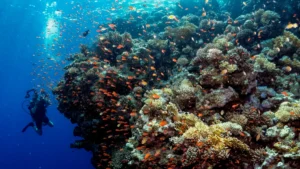Extinction Rates Could Be 10 Times Worse Than We Thought
Yet again, researchers confirm that climate change threatens the natural world with a soaring extinction toll. OLHA ZAIKA / Unsplash
OLHA ZAIKA / Unsplash
Two scientists want the world to think again about the extinction toll, the rate at which species could vanish as the planet warms. They warn that the worst fears so far may have been based on underestimates. Tomorrow’s rates of extinction could be 10 times worse.
That is because the loss of one or two key species could turn into a cascade that could spell the end for whole ecosystems. “Primary extinctions driven by environmental change could be just the tip of an enormous extinction iceberg,” they warn.
In their study, long before the complete loss of one species, other species locked into the same ecosystem started to perish. There is no need to worry about the rare but real hazard of an asteroid impact, or a burst of gamma rays from a nearby exploding star. The message from the simulators is that global average warming of between 5° and 6°C above the level for most of history since the end of the last Ice Age would be enough to wipe out most life on the hypothetical Earths.
“This makes it difficult to be optimistic about the future of species diversity in the ongoing trajectory of global change, let alone in the case of additional external, extraplanetary catastrophes.”
Giovanni Strona of the European Commission’s joint research centre in Ispra, Italy and Corey Bradshaw of Finders University in Adelaide, Australia write in the journal Scientific Reports that they turned to computer simulation to resolve an enduring ecological question: quite what is it that drives biodiversity loss?
“Whenever a species leaves our planet, we lose much more than a name on a list.”
The growth in human numbers, and the exploitation of the planet’s surface for economic growth, has destroyed habitats and disrupted ecosystems on a scale without parallel: global warming and climate change will make things worse.
Researchers have confirmed, repeatedly, that ecosystems are under threat; that climate change could be even more damaging than anyone suspected; that half of 976 species in one study were already being extinguished in local ecosystems, even if they survived elsewhere as the thermometer rose.
But most such studies were based on sample examinations of specific patches of woodland, grassland, marsh or lake, or surveys of published literature, and they measured change in a planet that has – since the beginning of the Industrial Revolution – warmed by about 1°C as a consequence of profligate combustion of fossil fuels and the clearance of the great forests. The latest study involved testing life on a planet to destruction.
The two scientists constructed 2,000 “virtual Earths” and populated them with interacting species: that is with a food web composed of competing predators and prey, multiple consumers and consumed. Then they subjected these notional biospheres to extreme environmental change, ranging from runaway global warming driven by ever-greater greenhouse gas emissions to the sudden, intense cooling of a “nuclear winter” in which sunlight is blocked by the dust of global thermonuclear war.
And the experiments, they say, demonstrated, once again, the co-dependency of living things in a stable environment. They set up two scenarios. In one of them a species was subjected to temperature change to the point of extinction. In the other, the researchers triggered a series of co-extinction cascades. They then matched the two outcomes.
More than species
And they found that failure to take into account the complex, entangled interdependencies of living things led to an underestimate, by 10 times, of the magnitude of mass extinction by climate change alone. The message is: don’t just save the giant panda, save the forest.
“Conservationists and decision makers need to move fast beyond a species-specific approach, and look with increasing attention at interaction networks as a fundamental conservation target,” Dr Strona said. “Whenever a species leaves our planet, we lose much more than a name on a list.”
Other such simulations have delivered catastrophic conclusions: one examination of runaway global warming left the Earth uninhabitable, while another found that in the most dreadful outcomes, at least one life form, the tardigrade, might survive.
Any computer model of life on Earth must have its weaknesses, if only because the unknown and unnamed list of creatures is at least 10 times greater than those already catalogued in the world’s botanical gardens, zoos and natural history museums. That is, biologists still don’t know nearly enough about the diversity of life on Earth. There are, the researchers concede, “obvious limitations in our ambitions model.”
But, said Dr Strona: “Our results are consistent with real-world patterns for which we have empirical evidence. This makes us confident that the many assumptions we had to take in order to build a functional model are sound. On the other hand, it would be misleading to just focus on raw numbers.”
Your support is crucial…With an uncertain future and a new administration casting doubt on press freedoms, the danger is clear: The truth is at risk.
Now is the time to give. Your tax-deductible support allows us to dig deeper, delivering fearless investigative reporting and analysis that exposes what’s really happening — without compromise.
Stand with our courageous journalists. Donate today to protect a free press, uphold democracy and unearth untold stories.






You need to be a supporter to comment.
There are currently no responses to this article.
Be the first to respond.